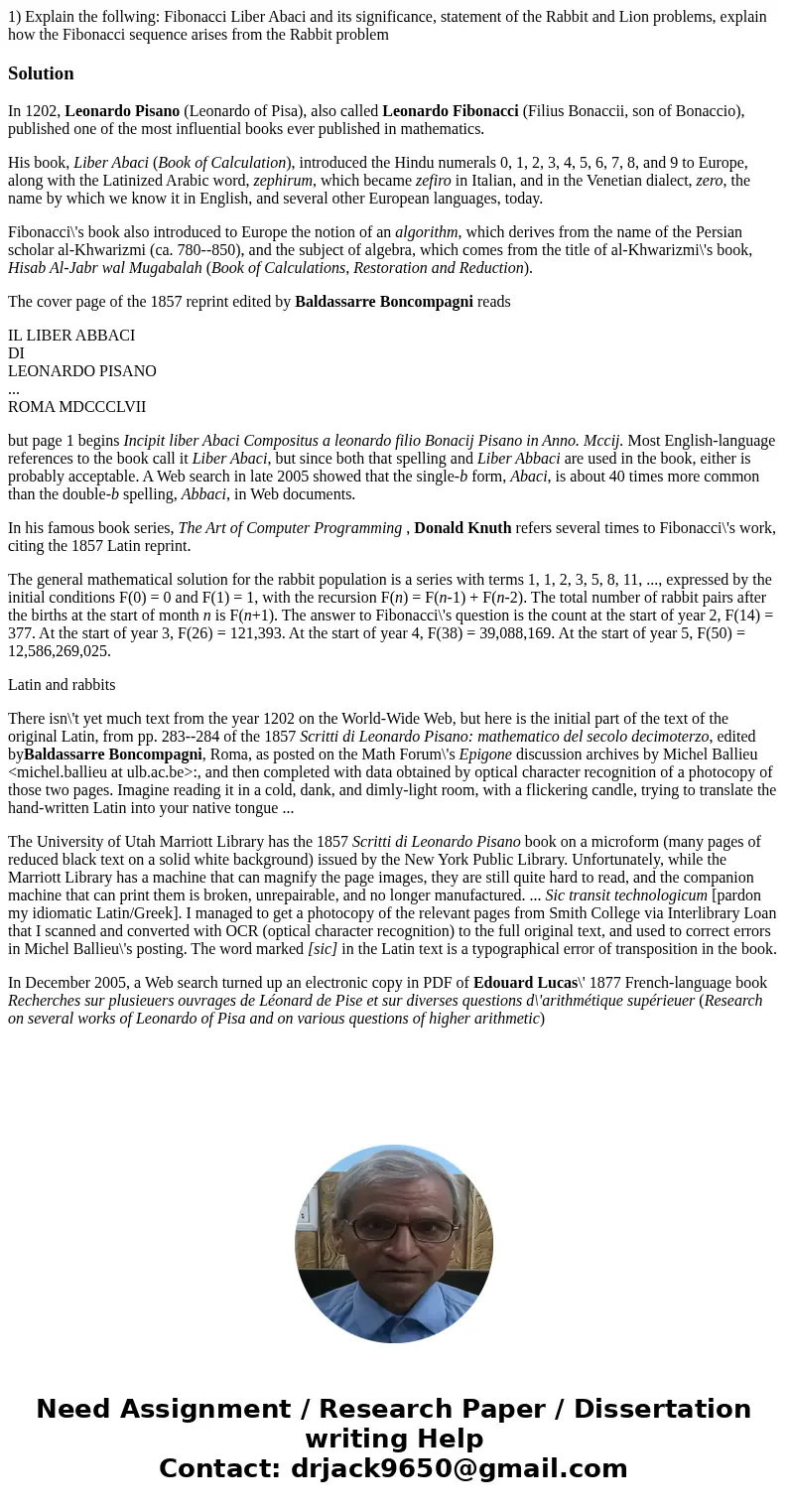1 Explain the follwing Fibonacci Liber Abaci and its signifi
1) Explain the follwing: Fibonacci Liber Abaci and its significance, statement of the Rabbit and Lion problems, explain how the Fibonacci sequence arises from the Rabbit problem
Solution
In 1202, Leonardo Pisano (Leonardo of Pisa), also called Leonardo Fibonacci (Filius Bonaccii, son of Bonaccio), published one of the most influential books ever published in mathematics.
His book, Liber Abaci (Book of Calculation), introduced the Hindu numerals 0, 1, 2, 3, 4, 5, 6, 7, 8, and 9 to Europe, along with the Latinized Arabic word, zephirum, which became zefiro in Italian, and in the Venetian dialect, zero, the name by which we know it in English, and several other European languages, today.
Fibonacci\'s book also introduced to Europe the notion of an algorithm, which derives from the name of the Persian scholar al-Khwarizmi (ca. 780--850), and the subject of algebra, which comes from the title of al-Khwarizmi\'s book, Hisab Al-Jabr wal Mugabalah (Book of Calculations, Restoration and Reduction).
The cover page of the 1857 reprint edited by Baldassarre Boncompagni reads
IL LIBER ABBACI
DI
LEONARDO PISANO
...
ROMA MDCCCLVII
but page 1 begins Incipit liber Abaci Compositus a leonardo filio Bonacij Pisano in Anno. Mccij. Most English-language references to the book call it Liber Abaci, but since both that spelling and Liber Abbaci are used in the book, either is probably acceptable. A Web search in late 2005 showed that the single-b form, Abaci, is about 40 times more common than the double-b spelling, Abbaci, in Web documents.
In his famous book series, The Art of Computer Programming , Donald Knuth refers several times to Fibonacci\'s work, citing the 1857 Latin reprint.
The general mathematical solution for the rabbit population is a series with terms 1, 1, 2, 3, 5, 8, 11, ..., expressed by the initial conditions F(0) = 0 and F(1) = 1, with the recursion F(n) = F(n-1) + F(n-2). The total number of rabbit pairs after the births at the start of month n is F(n+1). The answer to Fibonacci\'s question is the count at the start of year 2, F(14) = 377. At the start of year 3, F(26) = 121,393. At the start of year 4, F(38) = 39,088,169. At the start of year 5, F(50) = 12,586,269,025.
Latin and rabbits
There isn\'t yet much text from the year 1202 on the World-Wide Web, but here is the initial part of the text of the original Latin, from pp. 283--284 of the 1857 Scritti di Leonardo Pisano: mathematico del secolo decimoterzo, edited byBaldassarre Boncompagni, Roma, as posted on the Math Forum\'s Epigone discussion archives by Michel Ballieu <michel.ballieu at ulb.ac.be>:, and then completed with data obtained by optical character recognition of a photocopy of those two pages. Imagine reading it in a cold, dank, and dimly-light room, with a flickering candle, trying to translate the hand-written Latin into your native tongue ...
The University of Utah Marriott Library has the 1857 Scritti di Leonardo Pisano book on a microform (many pages of reduced black text on a solid white background) issued by the New York Public Library. Unfortunately, while the Marriott Library has a machine that can magnify the page images, they are still quite hard to read, and the companion machine that can print them is broken, unrepairable, and no longer manufactured. ... Sic transit technologicum [pardon my idiomatic Latin/Greek]. I managed to get a photocopy of the relevant pages from Smith College via Interlibrary Loan that I scanned and converted with OCR (optical character recognition) to the full original text, and used to correct errors in Michel Ballieu\'s posting. The word marked [sic] in the Latin text is a typographical error of transposition in the book.
In December 2005, a Web search turned up an electronic copy in PDF of Edouard Lucas\' 1877 French-language book Recherches sur plusieuers ouvrages de Léonard de Pise et sur diverses questions d\'arithmétique supérieuer (Research on several works of Leonardo of Pisa and on various questions of higher arithmetic)

 Homework Sourse
Homework Sourse